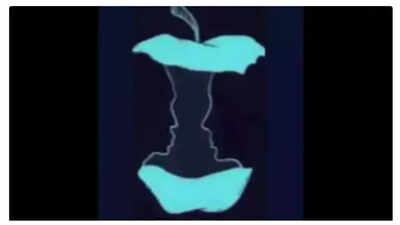Optical illusions are captivating visual puzzles that challenge our brains and test our observational skills. These mind-bending images provide a fun way to exercise the mind. An optical illusion occurs when our brain misinterprets the information our eyes send, leading us to perceive things differently from reality.

This particular illusion, originally shared by Marina Winberg, presents viewers with a choice: do you see an eaten apple or two faces? Your initial perception may reveal surprising insights into your personality. Take a moment to study the image and determine what stands out to you first. Then, read on to uncover what your choice reveals.
Winberg explains, "This image is a classic dual-illusion where you can either see two faces (a man and a woman) looking at each other OR an apple core—what you notice first says a lot about your mindset!"
If You See Two Faces First:
According to Winberg, spotting the two faces first suggests: "You’re a logical, analytical thinker with strong morals. You think before you act, value stability, and solve problems creatively— but sometimes, curiosity gets the best of you!”
If You See the Apple First:
Those who immediately see the apple core may possess different traits. Winberg suggests this indicates: “You’re intuitive, emotionally aware, and great at reading subtle cues. You know the right thing to say, but often stay quiet. Stability matters to you, and you protect what’s important.”
To further appreciate the complexity of optical illusions, it's helpful to understand the three main categories:
Literal Illusions: These illusions occur when the brain pieces together elements of an image to create a perception that doesn't truly exist. For instance, the classic example of an image that can be seen as either two faces or a vase falls into this category.
Physiological Illusions: These illusions arise from overstimulation of the visual system. Factors like excessive exposure to bright light, rapid movement, or intense color can trigger effects such as afterimages or the illusion of motion in a static image.
Cognitive Illusions: Cognitive illusions tap into the brain's subconscious interpretation of visual information. A prime example is the Müller-Lyer illusion, where lines appear to be of different lengths based on the surrounding shapes, even when they are identical.
Newer articles
Older articles
 New Zealand Cricket Announces Packed 2025-26 Home Summer Against Cricket Giants
New Zealand Cricket Announces Packed 2025-26 Home Summer Against Cricket Giants
 Ayesha Shroff’s REACTS to influencer telling her son, Tiger Shroff, to stop acting’: 'And you are who exactly'
Ayesha Shroff’s REACTS to influencer telling her son, Tiger Shroff, to stop acting’: 'And you are who exactly'
 Vitamin D deficiency can increase the risk of pancreatic cancer; know key symptoms
Vitamin D deficiency can increase the risk of pancreatic cancer; know key symptoms
 India Poised to Unleash First Dengue Vaccine as Phase 3 Trials Wrap Up
India Poised to Unleash First Dengue Vaccine as Phase 3 Trials Wrap Up
 Relationship Roadblocks: Spotting Early Signs of Commitment Phobia
Relationship Roadblocks: Spotting Early Signs of Commitment Phobia
 Prada Admits Kolhapuri Chappal Influence After Design Controversy
Prada Admits Kolhapuri Chappal Influence After Design Controversy
 5 Overlooked Warning Signs of Colon Cancer: What You Need to Know
5 Overlooked Warning Signs of Colon Cancer: What You Need to Know
 Cricketer Nitish Rana Eyes Delhi Comeback After Disappointing Uttar Pradesh Stint
Cricketer Nitish Rana Eyes Delhi Comeback After Disappointing Uttar Pradesh Stint
 Bangladesh Test Captain Najmul Hossain Shanto Resigns After Sri Lanka Defeat
Bangladesh Test Captain Najmul Hossain Shanto Resigns After Sri Lanka Defeat
 SA20 Auction: Teams Can Keep Up to Six Players, Purse Increased to $2.3M
SA20 Auction: Teams Can Keep Up to Six Players, Purse Increased to $2.3M